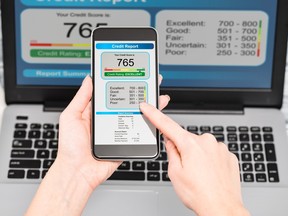How to build credit and maintain a good score

How to build credit and maintain a good score

Article content
The credit rating system can feel like a mysterious force, controlling your financial fate. A high score can pave the way for approvals on a new credit card, loan, or even rental apartment, while a low one will bring on high interest rates and restrictive terms or conditions that hold you back from achieving your goals. If you’re starting from scratch, building a solid credit rating may seem intimidating, but it’s entirely doable with the right strategies.
THIS CONTENT IS RESERVED FOR SUBSCRIBERS ONLY
Subscribe now to read the latest news in your city and across Canada.
- Exclusive articles from Barbara Shecter, Joe O'Connor, Gabriel Friedman, and others.
- Daily content from Financial Times, the world's leading global business publication.
- Unlimited online access to read articles from Financial Post, National Post and 15 news sites across Canada with one account.
- National Post ePaper, an electronic replica of the print edition to view on any device, share and comment on.
- Daily puzzles, including the New York Times Crossword.
SUBSCRIBE TO UNLOCK MORE ARTICLES
Subscribe now to read the latest news in your city and across Canada.
- Exclusive articles from Barbara Shecter, Joe O'Connor, Gabriel Friedman and others.
- Daily content from Financial Times, the world's leading global business publication.
- Unlimited online access to read articles from Financial Post, National Post and 15 news sites across Canada with one account.
- National Post ePaper, an electronic replica of the print edition to view on any device, share and comment on.
- Daily puzzles, including the New York Times Crossword.
REGISTER / SIGN IN TO UNLOCK MORE ARTICLES
Create an account or sign in to continue with your reading experience.
- Access articles from across Canada with one account.
- Share your thoughts and join the conversation in the comments.
- Enjoy additional articles per month.
- Get email updates from your favourite authors.
THIS ARTICLE IS FREE TO READ REGISTER TO UNLOCK.
Create an account or sign in to continue with your reading experience.
- Access articles from across Canada with one account
- Share your thoughts and join the conversation in the comments
- Enjoy additional articles per month
- Get email updates from your favourite authors
Sign In or Create an Account
or
Article content
Article content
Before explaining the how-to, it’s worth highlighting what a credit score is and how it is calculated. In Canada, your credit scores are calculated by the two major credit bureaus, Equifax Canada and TransUnion Canada, based on reports to them about your credit-related behaviour. This includes how you’ve handled debts such as credit cards or loans, and in some cases, even bill payments.
Article content
Article content
By signing up you consent to receive the above newsletter from Postmedia Network Inc.
Article content
Lenders rely on this score to gauge the risk of lending to you. Your scores may differ between the two credit bureaus and each lender chooses how to interpret or use your score. A higher score shows you’re a dependable borrower and repay your obligations as agreed. For those with no credit history, perhaps because you’re a newcomer to Canada, a young adult starting your financial journey, or have had past financial troubles wiped clean, building this score from the ground up is often a priority.
Article content
Start with a secured credit card
Article content
One of the most effective ways to begin building credit is through a secured credit card. Unlike traditional credit cards, which usually require an established credit rating to qualify, a secured card asks for a cash deposit upfront, usually between $200 and $1,000, which is held by the lender. This deposit acts as your credit limit and serves as security for the lender. For instance, if you deposit $500, that’s the amount you can spend. The trick is to use the card wisely — think small purchases such as a tank of gas or a recurring bill — and pay off the full balance every month. You must actively use credit to build up a rating, so by doing this consistently, you show lenders you can manage credit responsibly.
Article content
Article content
Leverage everyday payments
Article content
Article content
Utility bills aren’t normally reported to the credit bureaus, but if you fall behind, the collection agency will report your arrears and the impact to your credit rating can be significant. The exception is a cell phone contract held in your own name. While a phone contract is not a substitute for a secured credit card, a contract can serve as an additional tool to demonstrate your ability to manage regular financial obligations. The key is to only take on the commitment if you can manage it effectively, ensuring that your payment history remains unblemished.
Article content
Practice good credit habits
Article content
While starting with the right tools is essential, maintaining good credit habits is what keeps your score moving in the right direction. Paying all your bills on time is non-negotiable; late payments will dent your score and linger on your report for years. Another critical habit is to keep your credit utilization low, which means not maxing out your available credit. For example, if your card has a $500 limit, try to keep your balance below about $350, or 70 percent of the limit, to avoid looking overstretched.







